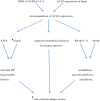Potential mechanisms of hemorrhagic stroke in elderly COVID-19 patients
- PMID: 32527987
- PMCID: PMC7346040
- DOI: 10.18632/aging.103335
Potential mechanisms of hemorrhagic stroke in elderly COVID-19 patients
Abstract
The novel severe acute respiratory syndrome coronavirus 2 is the causative agent of coronavirus disease 2019, a new human infectious disease. While fever, cough, and respiratory distress are typical first symptoms, a fraction of those affected present instead with neurological symptoms suggestive of central nervous system compromise. This review summarizes the potential contribution of coronavirus disease 2019 to hemorrhagic stroke in the elderly and proposes possible mechanisms. Reports show that the most affected patients have underlying chronic diseases such as hypertension and diabetes, which are two key risk factors for hemorrhagic stroke. Angiotensin-converting enzyme 2 is the main host cell surface receptor interacting with the severe acute respiratory syndrome coronavirus 2 spike glycoprotein to allow viral entry and infection. We speculate that ensuing downregulation of angiotensin-converting enzyme 2 expression may compound the risk conferred by pre-existing comorbidities and critically influence the pathogenesis of hemorrhagic stroke by elevating blood pressure and impairing cerebrovascular endothelial function. Additionally, both age- and/or disease-related immune dysfunction and enhanced catecholamine release secondary to anxiety and stress may also aggravate central nervous system symptoms of severe acute respiratory syndrome coronavirus 2 infection. Thus, assessment of systemic inflammatory biomarkers and tight control of hemodynamic parameters upon admission are crucial to minimize mortality and morbidity in coronavirus disease 2019 patients with central nervous system symptoms suggestive of incipient stroke.
Keywords: ACE2; COVID-19; SARS-CoV-2; hemorrhagic stroke; immunity.
Conflict of interest statement
Figures

References
-
- Gorbalenya AE, Baker SC, Baric RS, de Groot RJ, Drosten C, Gulyaeva AA, Haagmans BL, Lauber C, Leontovich AM, Neuman BW, Penzar D, Perlman S, Poon LL, et al. Severe acute respiratory sydrome-related coronavirus: The species and its viruses-a statement of the Coronavirus Study Group. bioRxiv. 2020. 10.1101/2020.02.07.937862 - DOI
-
- To KK, Tsang OT, Leung WS, Tam AR, Wu TC, Lung DC, Yip CC, Cai JP, Chan JM, Chik TS, Lau DP, Choi CY, Chen LL, et al.. Temporal profiles of viral load in posterior oropharyngeal saliva samples and serum antibody responses during infection by SARS-CoV-2: an observational cohort study. Lancet Infect Dis. 2020; 20:565–74. 10.1016/S1473-3099(20)30196-1 - DOI - PMC - PubMed
-
- Li J, Wang Y, Gilmour S, Wang M, Yoneoka D, Wang Y, You X, Gu J, Hao C, Peng L, Du Z, Xu DR, Hao Y. Estimation of the epidemic properties of the 2019 novel coronavirus: A mathematical modeling study. bioRxiv. 2020. 10.2139/ssrn.3542150 - DOI
Publication types
MeSH terms
LinkOut - more resources
Full Text Sources
Medical
Miscellaneous

